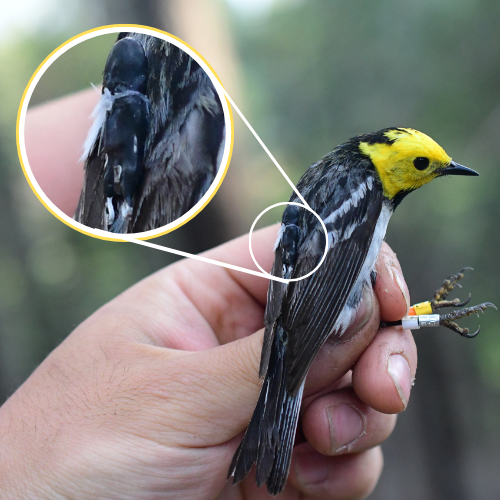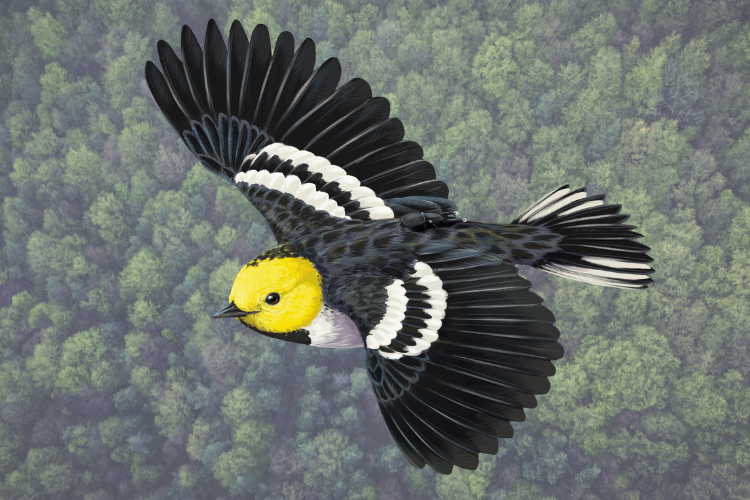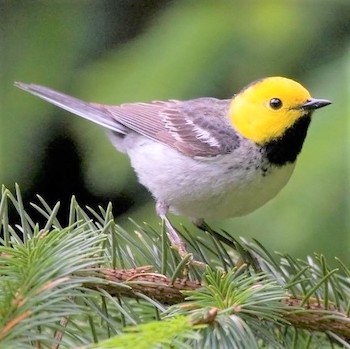As its name suggests, the Hermit Warbler keeps to itself, away from prying human eyes. Though they have bright yellow heads, you’re more likely to hear, rather than see, one of these little Neotropical migrant songbirds because they tend to stay high in the treetops of coniferous forests where they breed in the mountains of southern Washington, Oregon, and central and northern California. Because their secretive nature makes them difficult to study, little is known about the Hermit Warbler’s ecology, behavior, or migration. However, data from the Breeding Bird Survey suggests that this species is declining across its range, and in Washington and California’s Sierra Nevada in particular.
In a recent study published in Avian Conservation and Ecology, Hankyu Kim, now a faculty member at Kyung Hee University in Seoul, Korea, along with colleagues including IBP’s Rodney Siegel, examined migratory connectivity in Hermit Warblers using geolocators. Understanding migratory connectivity, or where different breeding populations of a species spend the non-breeding period, is critical to conserving migratory species that may face threats in different parts of their range as they move through their annual migration cycle.
The geolocators used in this study record light levels and time- data that can be used to estimate latitude and longitude. (For more on how this works, see our blog post from the start of this study: Where in the World Did That Hermit Warbler Go?) These tiny devices are small and light enough to be used on small songbirds like warblers. The downside is that they don’t transmit their data, so birds tagged with geolocators must be recaptured so that the devices can be retrieved.

A Hermit Warbler wearing a geolocator device. Photo by Hankyu Kim. Circular window shows zoomed in view of the geolocator.
Kim and colleagues deployed these transmitters on Hermit Warblers in seven locations spanning their breeding range, including Yosemite National Park in the spring and summer of 2019 intending to recapture the birds when they returned to their breeding territories the following year to retrieve the geolocators and the data they carried. But we all know what happened in 2020. Siegel explained how they managed to salvage the Yosemite portion of the study:
“Hankyu and I tagged those warblers in Yosemite in summer 2019 when Hankyu was a PhD student at Oregon State University, and then when it was time to try to recapture them in the spring of 2020 the world was largely shut down due to COVID, and Yosemite was closed to visitors. Hankyu, his wife Min-Su, and I got special permission to enter the park and recapture the birds - but we didn't see anyone else in the park the whole time. We camped separately from one another (outside the park), masked in the field, and took great care to not touch any of the same net poles or banding equipment. Crazy times!”
In addition to the challenges of navigating COVID safety in the field before transmission was well understood, the wily warblers made the 2020 field season difficult in other ways. Kim explains:
“Some birds apparently 'understood' our plans to recapture them in the following year. One of the birds at our field site in Yosemite evaded the net for two long days until we finally had to let him be. Some of these evasive birds seemed to become suspicious of the recorded songs we used as lures, and we ran out of all available recordings including recordings of their own songs. We made some complex mist net configurations to trick the birds, but it did not work for some birds that outsmarted us!”
Nevertheless, Kim persisted! He was able to recover enough geolocators and gather enough data to complete the first study of migratory connectivity in this species. Kim and colleagues found that Hermit Warbler breeding populations from up and down the West Coast mix together during the non-breeding season across the non-breeding range in southern Mexico and Central America. “Given their long latitudinal range from Washington to California, I expected so see some degree of migratory connectivity, which means that different breeding populations winter in different locations,” says Kim. “So, the strong mixture was a bit of a surprise.”
However, the Hermit Warblers that bred in Yosemite, in the southern part of the species breeding range, spent the non-breeding season in the most eastern part of the non-breeding range- southeastern Mexico. Though the sample size of birds tracked from Yosemite was small, this suggests a form of chain migration in which these more southeasterly breeding populations are migrating to southeasterly portions of the non-breeding range. Deforestation in this part of Mexico has been particularly severe in recent years and may contribute to the decline of the Sierra Nevada breeding population of this species.
The researchers also found that Hermit Warblers migrated relatively quickly during northbound migration to the breeding grounds, but more slowly on the way south to the non-breeding grounds. Kim and colleagues hypothesize that the faster migration north may reflect competition to establish favorable breeding territories. In addition, birds need to time their breeding so that it coincides with the flush of food resources (insects) in spring. This is seen in many other species of migratory birds.
Hermit Warblers are known to molt soon after the breeding season, which coincides with their migration south. Kim and coauthors suggest that the slower progress of the post-breeding migration may be because the birds are molting as they migrate through the mountains of Northern California and the Sierra Nevada. Anecdotally, Kim notes that he caught Hermit Warblers undergoing flight feather and body feather molt in early July. The authors describe the proposed molt migration in Hermit Warblers as a “continuous” rather than a “stopover” molt migration seen in other species because the warblers apparently do not stop migration for an extended period to complete their molt, but rather move slowly but steadily towards the non-breeding grounds while they molt.
This study highlights the importance of Sierra Nevada forests for the conservation of this species, as the populations that breed there are in decline, and populations that breed farther north undergo molt, an energetically demanding process, as they migrate through this region. Kim recommends further study of migratory connectivity in the southern portions of the Hermit Warbler’s breeding range- including the Sierra Nevada- to boost sample sizes and further elucidate migration connectivity patterns for this population.





